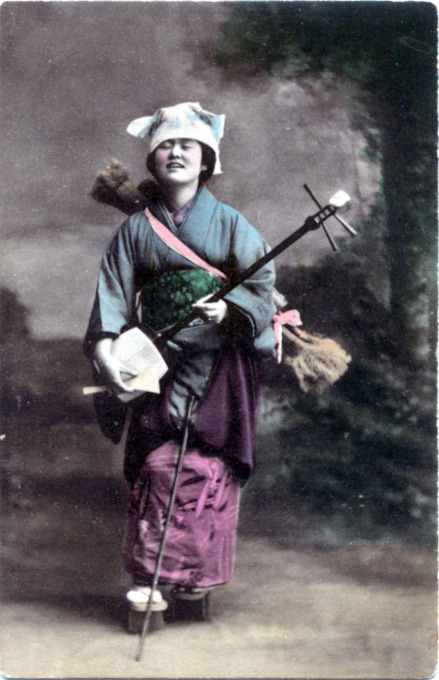
A goze [blind woman] samisen player, c. 1910, playing the instrument with her walking stick balanced against her kimono.
“Well into the twentieth century this stretch of coast was the haunt of the goze [blind-woman] – blind wandering shamisen players who trudged through the villages of the old province of Echigo, from wedding to wedding, from festival to festival, begging food and lodging in return for a song.
“All were women (though the shamisen is an instrument traditionally taken up by the blind of both sexes), and most were members of a strictly hierarchical society that organized them into small dependent bands.
“The younger and more ambitious of the goze might supplement their pittance of an income by selling their bodies at the village fairs, though if this were known to the society, they would quickly find themselves stripped of companionship and forced to wander through the Back of Japan alone, with only a stick and their songs to survive on.”
– The Roads to Sata: A 2000-Mile Walk Through Japan, by Alan Booth, 1985
From the wiki: “The shamisen, or samisen, also called ‘sangen‘, is a three-stringed Japanese musical instrument played with a plectrum called a ‘bachi’. It is believed that the ancestor of the shamisen was introduced in the 16th century at Sakai, Japan, near Osaka, from China via the Ryukyu Islands.
“The shamisen can be played solo or with other shamisen, in ensembles with other Japanese instruments, with singing such as nagauta, or as an accompaniment to drama, notably Kabuki and Bunraku. Both men and women traditionally played the shamisen.
“The samisen, being plucked, produces the same sharp attack to every note and the consequent lack of legato quality. It is also capable of producing the intermediate tones of the human voice. In scenes of weeping, for example, the samisen underlines the movement of the character’s body as he weeps and then, musically, takes over the sound of ‘weeping’ … There is the greatest freedom of movement between the actor’s voice, the narrator’s voice, and the music of the samisen.”
– The Kabuki Theatre, Earle Ernst, 1956
“The most famous and perhaps most demanding of the narrative styles is gidayū, named after Takemoto Gidayū (1651–1714), who was heavily involved in the bunraku puppet-theater tradition in Osaka. The gidayū shamisen and its plectrum are the largest of the shamisen family, and the singer-narrator is required to speak the roles of the play, as well as to sing all the commentaries on the action. The singer-narrator role is often so vocally taxing that the performers are changed halfway through a scene.
“From the 19th century female performers known as onna-jōruri or onna gidayū also carried on this concert tradition.”

